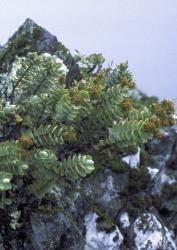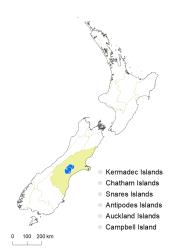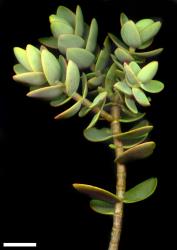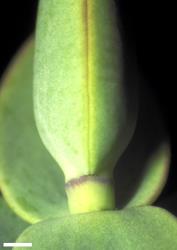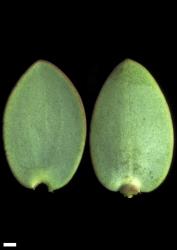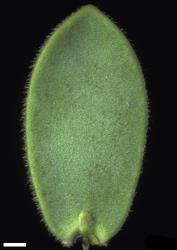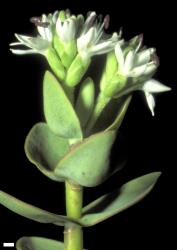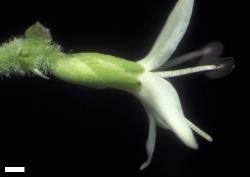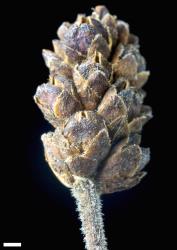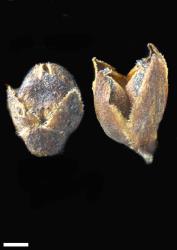- ≡ Hebe amplexicaulis (J.B.Armstr.) Cockayne & Allan, Trans. & Proc. New Zealand Inst. 56: 26 (1926)
- = Hebe allanii Cockayne, Trans. & Proc. New Zealand Inst. 56: 25 (1926)
- ≡ Hebe amplexicaulis f. hirta Garn.-Jones & Molloy, New Zealand J. Bot. 20: 395 (1983 [1982]) nom. nov. pro Hebe allanii Cockayne 1926
- = Hebe amplexicaulis var. erecta Cockayne & Allan, Trans. & Proc. New Zealand Inst. 56: 26 (1926)
- = Hebe amplexicaulis var. suberecta Cockayne & Allan, Trans. & Proc. New Zealand Inst. 56: 26 (1926)
Low shrub to 0.5 m tall. Branches decumbent to erect, glabrous or eglandular pubescent, hairs uniform or sometimes just a few near the leaf margins at the base. Leaf bud distinct, its leaves appressed at margins until fully grown; sinus absent. Leaves opposite-decussate, erecto-patent to spreading or sometimes recurved; lamina coriaceous, broadly oblong to elliptic to ovate, 8–30 mm long, 4–17 mm wide, dull, glaucous above and beneath; veins not evident or midrib weak beneath; surfaces glabrous or densely eglandular-hairy above and beneath; margin glabrous, entire; apex obtuse to sub-acute; base rounded to sub-cordate and amplexicaul; petiole absent. Inflorescence a lateral spike, 20–46 mm long; flowers crowded, 10–25, all bisexual; bracts opposite-decussate, sometimes becoming alternate above, ovate to deltoid to oblong, ≤ calyx; pedicels usually absent or 0–0.5 mm long, eglandular-hairy all around. Calyx lobes 4, obtuse to sub-acute, 2.5–3.6 mm long, sub-equal, glabrous or eglandular-hairy, with short, glandular hairs on margins as well. Corolla 7–10 mm diameter; tube white, 3.4–4.8 mm long, slightly > to 2× calyx, glabrous or eglandular hairy inside; lobes 4, white, sub-erect to spreading, unequal, lanceolate to elliptic, 4.0–4.5 mm long, acute to obtuse; nectar guides absent. Stamen filaments white, 3.8–4.0 mm long; anthers magenta or purple. Style glabrous or eglandular hairy, especially at base, 4–10 mm long. Capsules latiseptate, obtuse, eglandular-hairy all over or at least at the apex, 3–4 mm long, 1.8–2.2 mm at widest point. Seeds ellipsoid to discoid, flattened, smooth, straw-yellow to brown, 1.0–1.8 mm long.
Plants of 2 species that occur also in South Canterbury might be confused with V. amplexicaulis. These are V. pareora and V. pinguifolia, species that are also characterised by glaucous leaves. V. pareora plants, usually identified as V. amplexicaulis. before 1983, are readily distinguished by glabrous peduncles and fruits; they also have generally larger leaves that never have red edges, shortly pedicellate flowers, larger and broader corolla lobes, and capsules that are not so strongly flattened, ranging from broadly angustiseptate to narrowly latiseptate. V. pinguifolia may be distinguished by bifarious, short, stem pubescence, leaves that taper to the base, and a shorter corolla tube 2–3 mm long. Also, V. pinguifolia inflorescence and capsule hairs are short and stubbly (0.05–0.20 mm long) compared with the longer, shaggy hairs of V. amplexicaulis (0.30–0.50 mm).
Plants of V. albicans from Nelson could be confused with V. amplexicaulis, but are distinguished by their long corolla tubes and glabrous capsules. V. albicans plants often have larger leaves than plants of V. amplexicaulis.
South Island: Canterbury (Mt Somers, Mt Peel, Orari Gorge, Four Peaks Range).
Sub-alpine to alpine rock outcrops and debris, occasionally in forest. Recorded elevations range from 400 to 1525 m.
Flowers: October–January; fruits: February–April, persisting longer.
2n = 40 (see Bayly & Kellow 2006, as Hebe amplexicaulis).
Veronica amplexicaulis is classified in V. subg. Pseudoveronica sect. Hebe and the informal group “Subcarnosae” (Albach & Meudt 2010; Bayly & Kellow 2006).
Plants with hairy leaves, stems, calyx, and capsules were treated as a separate species by Cockayne (in Cockayne & Allan 1926, as Hebe allanii), but the hairy character state behaves as an allele at a single locus, with hairy dominant to glabrous (Garnock-Jones & Molloy 1983). Hairy plants can produce both hairy and glabrous progeny in nature and when self-pollinated by hand. Hairy plants (H. amplexicaulis forma hirta Garn.-Jones & Molloy) occur mixed with glabrous ones in the Four Peak and Mt Peel Ranges, reaching 20–40% of populations between 1200 and 1400 m, but the plants on Mt Somers are all glabrous (Garnock-Jones & Molloy 1983).
The leaf margins are bevelled and the bevelled surface is strictly glabrous, even on leaves that are otherwise hairy. Leaf edges are often red or yellowish. The hairs are relatively long and shaggy (0.3–0.5 mm long), and although their presence on leaves and stems varies, they are always densely present on peduncles. The peduncle is about = the flowering portion of the inflorescence.



